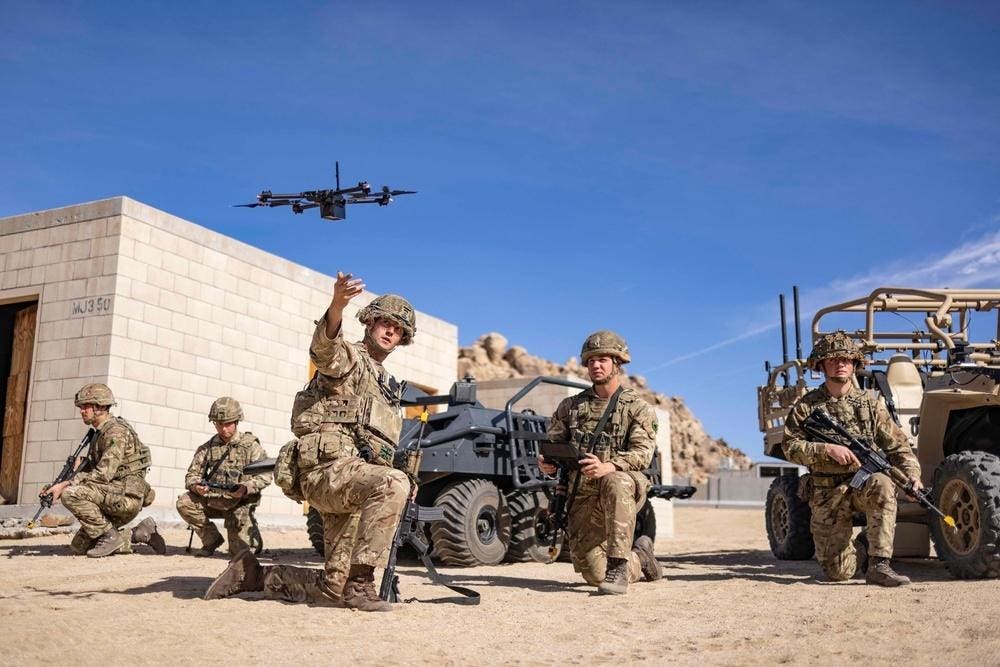Next Fall, an experiment will determine the potential for ground robotic vehicles, drones and robots to increase a platoon’s mobility and awareness by a factor of 10.
The demonstration, called the 10X Dismounted Infantry Platoon Project or “10X”, is funded by the U.S. Army’s Warren, Michigan-based Ground Vehicle Systems Center (GVSC). It will combine an infantry platoon with artificial intelligence-enabled robotic vehicles to enhance their mobility as well as drones, dog-robots and an ad hoc communications and control network to enhance their battlespace awareness.
Scheduled for a full demonstration in September 2024, at Fort Moore, Ga., the experimental project is being managed by the National Advanced Mobility Consortium (NAMC), a Michigan-based non-profit industry group of approximately 500 members.
For 10X, NAMC has brought together eight of its members including Auburn University, Bounce Imaging, Charles River Analytics, Inc., DPI LLC, KEF Robotics Inc., Lockheed Martin
LMT
GVSC is bringing additional technology vendors like General Dynamics
GD
“We are trying to improve a platoon’s performance on the battlefield by a factor of ten,” says NAMC’s chief technology officer, Andrew Dallas.
However, for the experiments envisioned, 10X performance does not mean making a platoon ten times more lethal. While lethality is the ultimate metric for any army formation, 10X is focused primarily on the mobility of the platoon as well as its mission-planning and situational awareness Dallas explains.
I asked whether the Army has any evidence that AI and robotics can yield a 10x improvement in these and translate them to combat effectiveness?
“We don’t. That’s what this is about,” Dallas replied.
With total funding of approximately $3.2 million, the project is quite small by comparison to major Army technology exercises like Project Convergence – a large scale technology integration exercise which the Army is not holding in 2023. That’s in keeping with sentiments expressed senior Army leaders earlier this year who said they want to strike a right balance between conducting expensive, large-scale exercises with new weapons, against smaller, more frequent events.
10X will build up to the final demonstration via six different events slated for the remainder of this year and next. These are beginning with simulation-based experiments in integrating the drone, robotic vehicle/dog, network and control technologies.
The simulations will allow the participating companies to learn each other’s systems and technical languages, taking the first steps to integrating their respective platforms. Gradual field integrations of the various elements will follow.
“We’ve had a lot of experience at this so we’ll step through different engineering and field events towards that demo,” NAMC’s CTO says.
The experimental platoon will be paired with GDLS’ S-MET (Small Multipurpose Equipment Transport) which is designed to unburden foot soldiers by carrying their supplies and mission essential equipment as well as modular mission payloads.
Boston Dynamics and Ghost Robotics are bringing their four-legged Spot and Vision 60 robots respectively to add ground surveillance, reconnaissance, inspection, load carriage and weapons capabilities to the platoon. DPI will bring its small, CH-46-like Tandem cargo UAS to add a measure of potential aerial resupply capability.
Command and control (C2) of the various ground and aerial assets will be effected via a beyond-line-of-sight mobile ad hoc network (MANET) supplied by Persistent Systems. KEF Robotics will lend its machine-learning (ML)-enabled navigation, hazard detection and avoidance software to the integration piece of the C2 problem.
The machines, software and humans will coalesce to whatever degree possible in a notional urban environment planned for the September 2024 demonstration. How well things come together is TBD but at least the demonstration will establish a baseline Dallas says.
“We don’t expect to reach ten-times performance whether it’s lethality or whatever. What we would like to do is identify what gaps are inhibiting us from taking steps toward 10X.”
The scope of 10X is manifestly limited, a concession to the fact that the Pentagon actually knows very little about how the compendium of advanced defense and commercial off the shelf technologies it has recently decided it urgently needs will work together or work at all.
For example, the battlespace awareness that the experiment seeks to multiply hinges on identifying what meaningful or superfluous data drones and robots are collecting, what targets or objects they’re tracking Dallas says.
From there, such data must be fed into a mission planning system in real time and periodic (possibly frequent) instruction to the robotic platforms and drones must be issued. At what distances are the command-control networks and communications supposed to work?
NAMC’s CTO struggled with an answer, likely for both technical and information classification reasons, before explaining that they’re expected to work “within normal human operation without these platforms”. That may be read as in line with the current distance over which Army platoons and squads expect to communicate with whatever assets they may now access in a combined arms fight.
How such range would apply or be useful in the oft-discussed hypothetical dispersed fighting scenarios of the Indo-Pacific that the Army is preparing for is simply beyond the scope of 10X.
“We haven’t looked any further than [an urban scenario] at a bigger operational picture,” Dallas acknowledges.
NAMC, which receives a fee for 10X and other projects from the government (GVSC in this case), is managing the year-long project with that narrow scope in mind. Dallas says that they’ve done some limited gaming of the scenarios a 10X platoon might face but the bulk of the experiment is getting soldiers “more familiar with using the technology”.
Beyond that, “The biggest challenge we have is integrating these disparate platforms together,” he adds. “These are prototype experiments. They’re not builds, not programs-of-record… If some [element] is not working, we may need to cut it and bring something else in.”
A ten-times more aware, more mobile army platoon is still a long march ahead. But every march begins with short first steps.
Read the full article here





